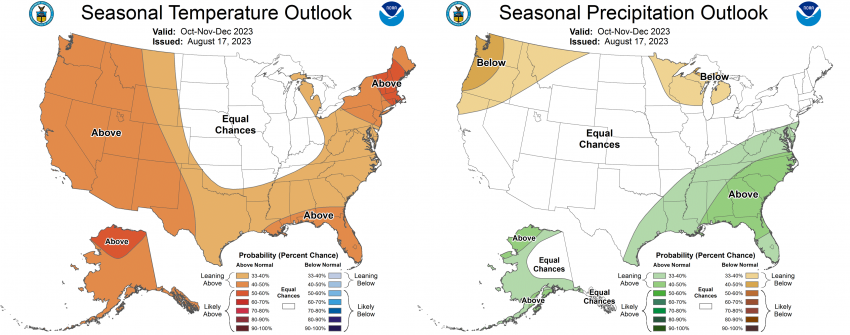Marcelo Wallau, UF/IFAS Forage Extension Specialist, Clyde Fraisse, UF/IFAS Agrometeorology, Leanne Dillard, Auburn University Forage Extension Specialist, and Henry Jordan, Auburn University Variety Testing Manager
Despite the record-high temperatures hitting the state, it is time to start thinking about the cool-season forage for livestock, cover crops for cropland, or plots for wildlife. Small grains, brassicas, clovers (and other legumes) and ryegrasses area great resource for farmers and hunters during the winter. Cool-season annual forages represent an important alternative for livestock feeding in the Southeastern United States, especially in Florida, Alabama and Georgia. Even though we are just reaching the peak of hurricane season (which is predicted to be “above normal” by the National Oceanic and Atmospheric Administration – NOAA), you need to start planning for fall plantings. Just as in past years, researchers across the southeast have updated their cool-season forage and wildlife food plot recommendations with the recent results from our variety trials across the three states, and based on industry feedback on what is available in the market this year. Here, we want to share a few important points and resources that can help you plan for the upcoming cool-season forage planting season.

Figure 1. Differences between triticale FL08128 (left) and oat Horizon 306 (right) varieties at the Milk Check-off demos in Florida, around 110 days after planting. Credit: Marcelo Wallau, UF/IFAS
–
Variety selection is probably the most important decision farmers can make when planning a new crop. When choosing species and varieties to plant, think about the intended use. There is a great difference between and within species (and between varieties) in terms of production, maturity date, disease and cold resistance. For example, while cover cropping requires a fast-growing variety (such as FL 401 rye), dairymen are interested in quality, frequently opting for an early oat (such as Legend 567) to be harvested before corn planting in early March. Cattlemen will opt for long season options including ryegrass, or blends that can extend grazing season, while awnless triticale and brassicas will be preferred for wildlife plots. For every situation, there is a best suited option.
Another important recommendation is to purchase certified seeds. Although more expensive, that certification ensures quality and purity, plus the advantage of the genetic merit (improved cultivars). Some of those cultivars are not readily available at your local store, so you might need to allow extra time to order them. Using blends of forages has great advantages especially for grazing systems. It is possible to extend the grazing season using forages of different maturities, enhance nutritive value and add nitrogen to the system when utilizing legumes. It also helps hedging against adverse weather conditions. Last year, many cool-season pastures (especially oat fields) were severely damaged by the abnormally cold weather between Christmas and New Year. Adding another small grain and ryegrass would have improved the pasture’s capacity to withstand the frost with minimum damage.
Here are the updated recommendation lists, and a few other useful resources when planning our cool-season pastures:
-
Florida 2023 Cool-season forage variety recommendations
-
Florida 2023 Wildlife food plot recommendations
-
Alabama Agricultural Experiment Station Variety Test Data
-
Ryegrass dataset from the Alabama trials
-
Overseeding Perennial Pastures & Hayfields with Cool-Season Annuals
–
Fertilizer prices have dropped compared to last season, which should decrease cost of production of winter crops. Cool-season grasses require high nitrogen fertilization for achieving the production potential. Split applications are always recommended, starting at planting or shortly after with a starter fertilizer (~ 30 lbs of N/A), and again at 45 days or so with 50 lbs of N/A to get an early first grazing. Afterwards, 50 lbs of N/A after each grazing cycle. Consult your local extension agent for more details of recommended fertilizer rates.
Don’t neglect grazing management. Grazing too early and too close will jeopardize the whole production season. Wait until forages are at least 12 inches tall before the first grazing, and always leave a good stubble after grazing. A rule of thumb is to remove half of the canopy height only. What is left is not waste; those leaves will ensure a fast regrowth for the next grazing cycle.
–
Is it worth planting?
According to our friend and commodity director for Alabama Farmer’s Association, Chris Prevatt, ryegrass is probably the cheapest gain you can put on cattle all season (listen to our Cow Talks podcast episode on Cool-season forage recommendations). Expanding on that cool-season forages can help reduce cost of hay (purchasing or production) and hay feeding, add significant gain on high demanding categories (such as replacement heifers and stockers), while also promoting soil health. It is a win-win situation. However, it does not come without risks. Planting season is normally a dry period, especially in Florida, when the convection summer rains are not happening anymore, and the cold fronts coming from the west are not strong yet.
–
What to expect for the climate in North Florida and Southern Alabama during the Fall of 2023?
Much has been discussed in the media about the climate extremes that have affected most of the US, especially the unrelenting series of summer heat waves observed in the South and Southwest of the country. As we look ahead to the Fall season, the attention is shifting to the potential effects of the El Niño phenomenon that is expected be present in the equatorial Pacific Ocean during upcoming autumn and winter seasons. Although NOAA and other sources of climate forecast predict a higher chance of above normal temperatures during Oct-Nov-Dec 2023, it is normally above average rainfall that dominates the headlines during El Niño years in North Florida and Southern Alabama. The NOAA outlook predicts the probability of above average rainfall to be between 50% to 60% which is consistent to what we have observed in the past (Figure 2). However, above normal temperatures can increase chances of pests and early season diseases, and delay dormancy of warm-season perennial forages for those planning on overseeding.

Figure 2. Seasonal temperature (left) and precipitation (right) outlook for Oct-Nov-Dec 2023. Source: National Oceanic and Atmospheric Administration
–
For more information on how El Niño may affect the weather in Florida, you can check the following factsheets:
–
You may also explore other related tools that allow you evaluate the effects using maps or specific weather stations across the southeast USA:
–
Other resources:
Join Dr. Marcelo Wallau on a tour of the 2023 Cool-Season variety demonstration plots at Shenandoah Dairy, FL, in March 2023
–
And listen to our latest episode of the Cow-talks podcast hosted by Marcelo Wallau and Chris Prevatt, featuring Dr. Ann Blount, Emeritus professor and forage breeder retired from the University of Florida, Dr. Leanne Dillard, forage extension specialist at Auburn University, and Henry Jordan, manager of the Auburn variety trials.
–
If you have any questions or would like or would like assistance planning your cool-season forages planting, reach out to us at forages@ifas.ufl.edu and consult with your local extension agent.
- UF/IFAS 2025 Top Rancher Challenge Showcases Youth and Adult Talent - July 11, 2025
- Cow Talks: Special Guests Discuss the Impact of H5N1 Avian Influenza on Agriculture - April 25, 2025
- Why is this weed here? Weed Management in Pasture Systems - February 28, 2025
